In Nordic mythology, Asgard is a location associated with the gods. It appears in a multitude of Old Norse sagas and mythological texts. It is described as the fortified home of the Æsir gods, often associated with gold imagery. Many of the best-known Nordic gods are Æsir or live in Asgard such as Odin, Thor, Loki, and Baldr.

Bragi is the skaldic god of poetry in Norse mythology.

In Norse mythology, Heimdall is a god. He is the son of Odin and nine mothers. Heimdall keeps watch for invaders and the onset of Ragnarök from his dwelling Himinbjörg, where the burning rainbow bridge Bifröst meets the sky. He is attested as possessing foreknowledge and keen senses, particularly eyesight and hearing. The god and his possessions are described in enigmatic manners. For example, Heimdall is emerald-toothed, "the head is called his sword," and he is "the whitest of the gods."

In Norse mythology, Ragnarök is a foretold series of impending events, including a great battle in which numerous great Norse mythological figures will perish ; it will entail a catastrophic series of natural disasters, including the burning of the world, and culminate in the submersion of the world underwater. After these events, the world will rise again, cleansed and fertile, the surviving and returning gods will meet, and the world will be repopulated by two human survivors, Líf and Lífþrasir. Ragnarök is an important event in Norse mythology and has been the subject of scholarly discourse and theory in the history of Germanic studies.
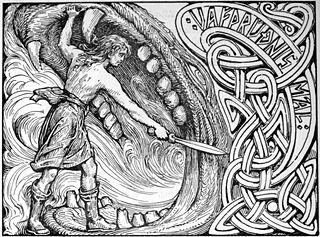
In Norse mythology, Víðarr is a god among the Æsir associated with vengeance. Víðarr is described as the son of Odin and the jötunn Gríðr and is foretold to avenge his father's death by killing the wolf Fenrir at Ragnarök, a conflict he is described as surviving. Víðarr is attested in the Poetic Edda, compiled in the 13th century from earlier traditional sources, the Prose Edda, written in the 13th century by Snorri Sturluson, and is interpreted as depicted with Fenrir on the Gosforth Cross. A number of theories surround the figure, including theories around potential ritual silence and a Proto-Indo-European basis.
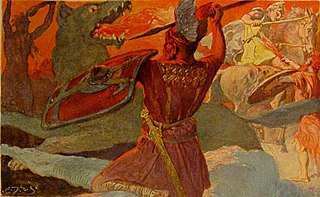
In Norse mythology, Vígríðr or Óskópnir is a large field foretold to host a battle between the forces of the gods and the forces of Surtr as part of the events of Ragnarök. The field is attested in the Poetic Edda, compiled in the 13th century from earlier traditional material, and in the Prose Edda, written by Snorri Sturluson in the 13th century. The Poetic Edda briefly mentions the field as where the two forces will battle, whereas the Prose Edda features a fuller account, foretelling that it is the location of the future death of several deities before the world is engulfed in flames and reborn.

Odin Borson, the All-Father is a fictional character appearing in American comic books published by Marvel Comics. First mentioned in Journey into Mystery #85, the character first appears in Journey into Mystery #86, and was adapted from the Odin of Norse mythology by Stan Lee and Jack Kirby. The character is depicted as the father of Thor and former king of Asgard.
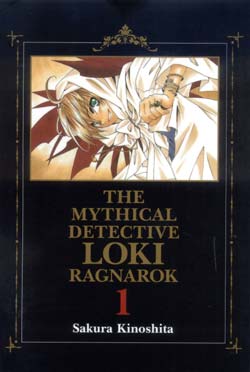
The Mythical Detective Loki Ragnarok is a manga by Sakura Kinoshita published from August 1999 to October 2004. A television anime based on the manga series ran for 26 episodes from April 5, 2003, to September 27, 2003, in Japan.
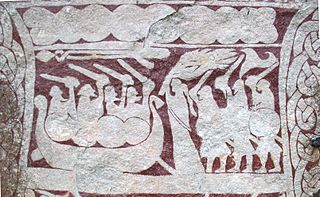
Sörla þáttr eða Heðins saga ok Högna is a short narrative from the extended version Óláfs saga Tryggvasonar en mesta found in the Flateyjarbók manuscript, which was written and compiled by two Christian priests, Jon Thordson and Magnus Thorhalson, in the late 14th century. The narrative begins 24 years after the death of Fróði, and takes place in the 9th and the 10th centuries. It is a composite tale containing a story of how Freyja acquired a necklace from the Dwarves, how that led to a bloody war, and how Olaf Tryggvason brought peace to the land.

Heimdall is a fictional character appearing in American comic books published by Marvel Comics. The character is based on the Norse deity Heimdall. Heimdall is described as all-seeing and all-hearing and is the sole protector of the Bifröst in Asgard.
The Norse mythology, preserved ancient Icelandic texts such as the Poetic Edda, the Prose Edda, and other lays and sagas, was little known outside Scandinavia until the 19th century. With the widespread publication of Norse myths and legends at this time, references to the Norse gods and heroes spread into European literary culture, especially in Scandinavia, Germany, and Britain. In the later 20th century, references to Norse mythology became common in science fiction and fantasy literature, role-playing games, and eventually other cultural products such as Japanese animation. Storytelling was an important aspect of Norse mythology and centuries later, with the rediscovery of the myth, Norse mythology once again relies on the impacts of storytelling to spread its agenda.
In Norse mythology, Sindri is the name of both a dwarf and a hall that will serve as a dwelling place for the souls of the virtuous after the events of Ragnarök. Sindri is also referred to as Eitri, the brother of Brokkr.

Surtur is a fictional character appearing in American comic books published by Marvel Comics, commonly as an enemy of Thor. Based on the fire giant Surtr from Norse mythology, he was adapted by writer Stan Lee and artist Jack Kirby, and first appeared in Journey into Mystery #97. The character was once described as one of "The Ten Most Heinous Enemies of the Mighty Thor".

Frigga is a fictional character appearing in American comic books published by Marvel Comics. The character appears in particular in those featuring the superhero Thor, who is Frigga's son. Based on both Frigg and Freyja of Norse mythology, she was created by writers Stan Lee and Robert Bernstein and artist Joe Sinnott, and first appeared in Journey into Mystery #92.
Jul i Valhal is a Danish television advent calendar. It first aired in the December 2005 on TV 2 Denmark television station, on TV 2 Norway in December 2006, in December 2007 on Swedish Barnkanalen and in December 2008 on Yle2. As a television advent calendar, it has 24 episodes, and one new episode was aired per day from 1 to 24 December.

Odd and the Frost Giants (2008) is a World Book Day book by Neil Gaiman. It draws on Norse mythology and also the historical Vikings.
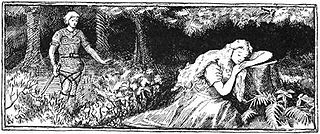
Skáldskaparmál is the second part of the Prose Edda, compiled by Snorri Sturluson. It consists of a dialogue between Ægir, the divine personification of the sea, and Bragi, the god of poetry, in which both stories of the Æsir and discourse on the nature of poetry are intertwined. The work additionally includes tales of human heroes and kings. The overarching mythological setup gradually fades and the work becomes more of an early form of a poetic thesaurus of Old Norse, presumably intended for usage by skalds. Much of the work is focused on poetic phrases and descriptors. The origin of these kennings is given; Bragi delivers a systematic list of kennings for various Æsir, people, places, and things. He then goes on to discuss poetic language in some detail, in particular heiti, essentially poetic synonyms or alternate words. For example, the simple hestr, "horse", might be replaced by jór, "steed".

Magnus Chase and the Gods of Asgard is a trilogy of fantasy novels based on Norse mythology written by American author Rick Riordan and published by Disney-Hyperion. It is set in the same universe as the Camp Half-Blood Chronicles and The Kane Chronicles series. The first book, The Sword of Summer, was released on October 6, 2015. The second book, The Hammer of Thor, was released on October 4, 2016. The Ship of the Dead, the third book, was released on October 3, 2017.

The Ship of the Dead is a young-adult fantasy novel based on Norse mythology written by American author Rick Riordan. It is the third and final novel in the Magnus Chase and the Gods of Asgard trilogy, preceded by The Hammer of Thor. It was released on October 3, 2017 by Disney-Hyperion, an imprint of Disney Book Group. The novel is narrated in the first-person view by Magnus Chase, 16-year-old demigod and homeless orphan. He and his crew sail to the farthest borders of Jotunheim and Niflheim in pursuit of Asgard's greatest threat.















